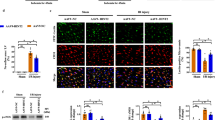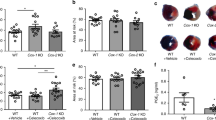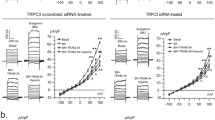Abstract
There is evidence that H2R blockade improves ischemia/reperfusion (I/R) injury, but the underlying cellular mechanisms remain unclear. Histamine is known to increase vascular permeability and induce apoptosis, and these effects are closely associated with endothelial and mitochondrial dysfunction, respectively. Here, we investigated whether activation of the histamine H2 receptor (H2R) exacerbates myocardial I/R injury by increasing mitochondrial and endothelial permeability. Serum histamine levels were measured in patients with coronary heart disease, while the influence of H2R activation was assessed on mitochondrial and endothelial function in cultured cardiomyocytes or vascular endothelial cells, and myocardial I/R injury in mice. The serum histamine level was more than twofold higher in patients with acute myocardial infarction than in patients with angina or healthy controls. In neonatal rat cardiomyocytes, histamine dose-dependently reduced viability and induced apoptosis. Mitochondrial permeability and the levels of p-ERK1/2, Bax, p-DAPK2, and caspase 3 were increased by H2R agonists. In cultured human umbilical vein endothelial cells (HUVECs), H2R activation increased p-ERK1/2 and p-moesin levels and also enhanced permeability of HUVEC monolayer. All of these effects were abolished by the H2R blocker famotidine or the ERK inhibitor U0126. After I/R injury or permanent ischemia, the infarct size was reduced by famotidine and increased by an H2R agonist in wild-type mice. In H2R KO mice, the infarct size was smaller; myocardial p-ERK1/2, p-DAPK2, and mitochondrial Bax were downregulated. These findings indicate that H2R activation exaggerates myocardial I/R injury by promoting myocardial mitochondrial dysfunction and by increasing cardiac vascular endothelial permeability.








Similar content being viewed by others
References
Adyshev DM, Moldobaeva NK, Elangovan VR, Garcia JG, Dudek SM (2011) Differential involvement of ezrin/radixin/moesin proteins in sphingosine 1-phosphate-induced human pulmonary endothelial cell barrier enhancement. Cell Signal 23:2086–2096. doi:10.1016/j.cellsig.2011.08.003
Arroyo-Flores B, Chi-Ahumada E, Briones-Cerecero E, Barajas-Espinosa A, Perez-Aguilar S, de la Rosa AB, Knabb M, Rubio R (2011) Cardiac ischemia and ischemia/reperfusion cause wide proteolysis of the coronary endothelial luminal membrane: possible dysfunctions. Open Cardiovasc Med J 5:239–245. doi:10.2174/1874192401105010239
Asanuma H, Minamino T, Ogai A, Kim J, Asakura M, Komamura K, Sanada S, Fujita M, Hirata A, Wakeno M, Tsukamoto O, Shinozaki Y, Myoishi M, Takashima S, Tomoike H, Kitakaze M (2006) Blockade of histamine H2 receptors protects the heart against ischemia and reperfusion injury in dogs. J Mol Cell Cardiol 40:666–674. doi:10.1016/j.yjmcc.2006.02.001
Bell RM, Kunuthur SP, Hendry C, Bruce-Hickman D, Davidson S, Yellon DM (2013) Matrix metalloproteinase inhibition protects CyPD knockout mice independently of RISK/mPTP signalling: a parallel pathway to protection. Basic Res Cardiol 108:331. doi:10.1007/s00395-013-0331-7
Bot I, de Jager SC, Zernecke A, Lindstedt KA, van Berkel TJ, Weber C, Biessen EA (2007) Perivascular mast cells promote atherogenesis and induce plaque destabilization in apolipoprotein E-deficient mice. Circulation 115:2516–2525. doi:CIRCULATIONAHA.106.660472
Clejan S, Japa S, Clemetson C, Hasabnis SS, David O, Talano JV (2002) Blood histamine is associated with coronary artery disease, cardiac events and severity of inflammation and atherosclerosis. J Cell Mol Med 6:583–592. doi:006.004.09
Dandekar RD, Khan MM (2011) Regulation of ERK2 phosphorylation by histamine in splenocytes. Immunopharmacol Immunotoxicol 33:250–258. doi:10.3109/08923973.2010.499913
Di Lisa F, Bernardi P (2006) Mitochondria and ischemia-reperfusion injury of the heart: fixing a hole. Cardiovasc Res 70:191–199. doi:10.1016/j.cardiores.2006.01.016
Di Lisa F, Carpi A, Giorgio V, Bernardi P (2011) The mitochondrial permeability transition pore and cyclophilin D in cardioprotection. Biochim Biophys Acta 1813:1316–1322. doi:10.1016/j.bbamcr.2011.01.031
Forward NA, Furlong SJ, Yang Y, Lin TJ, Hoskin DW (2009) Mast cells down-regulate CD4+CD25+ T regulatory cell suppressor function via histamine H1 receptor interaction. J Immunol 183:3014–3022. doi:jimmunol.0802509
Fukushima Y, Matsui T, Saitoh T, Ichinose M, Tateishi K, Shindo T, Fujishiro M, Sakoda H, Shojima N, Kushiyama A, Fukuda S, Anai M, Ono H, Oka M, Shimizu Y, Kurihara H, Nagai R, Ishikawa T, Asano T, Omata M (2004) Unique roles of G protein-coupled histamine H2 and gastrin receptors in growth and differentiation of gastric mucosa. Eur J Pharmacol 502:243–252. doi:S0014-2999(04)01021-0
Galaup A, Gomez E, Souktani R, Durand M, Cazes A, Monnot C, Teillon J, Le Jan S, Bouleti C, Briois G, Philippe J, Pons S, Martin V, Assaly R, Bonnin P, Ratajczak P, Janin A, Thurston G, Valenzuela DM, Murphy AJ, Yancopoulos GD, Tissier R, Berdeaux A, Ghaleh B, Germain S (2012) Protection against myocardial infarction and no-reflow through preservation of vascular integrity by angiopoietin-like 4. Circulation 125:140–149. doi:CIRCULATIONAHA.111.049072
Geoffrey R, Jia S, Kwitek AE, Woodliff J, Ghosh S, Lernmark A, Wang X, Hessner MJ (2006) Evidence of a functional role for mast cells in the development of type 1 diabetes mellitus in the BioBreeding rat. J Immunol 177:7275–7286. doi:177/10/7275
Gomez L, Paillard M, Price M, Chen Q, Teixeira G, Spiegel S, Lesnefsky EJ (2011) A novel role for mitochondrial sphingosine-1-phosphate produced by sphingosine kinase-2 in PTP-mediated cell survival during cardioprotection. Basic Res Cardiol 106:1341–1353. doi:10.1007/s00395-011-0223-7
Guo X, Wang L, Chen B, Li Q, Wang J, Zhao M, Wu W, Zhu P, Huang X, Huang Q (2009) ERM protein moesin is phosphorylated by advanced glycation end products and modulates endothelial permeability. Am J Physiol Heart Circ Physiol 297:H238–H246. doi:10.1152/ajpheart.00196.2009
Heusch G, Boengler K, Schulz R (2008) Cardioprotection: nitric oxide, protein kinases, and mitochondria. Circulation 118:1915–1919. doi:10.1161/CIRCULATIONAHA.108.805242
Heusch G, Boengler K, Schulz R (2010) Inhibition of mitochondrial permeability transition pore opening: the Holy Grail of cardioprotection. Basic Res Cardiol 105:151–154. doi:10.1007/s00395-009-0080-9
Heusch G, Kleinbongard P, Skyschally A, Levkau B, Schulz R, Erbel R (2012) The coronary circulation in cardioprotection: more than just one confounder. Cardiovasc Res 94:237–245. doi:10.1093/cvr/cvr271
Kim J, Ogai A, Nakatani S, Hashimura K, Kanzaki H, Komamura K, Asakura M, Asanuma H, Kitamura S, Tomoike H, Kitakaze M (2006) Impact of blockade of histamine H2 receptors on chronic heart failure revealed by retrospective and prospective randomized studies. J Am Coll Cardiol 48:1378–1384. doi:10.1016/j.jacc.2006.05.069
Li J, Umar S, Iorga A, Youn JY, Wang Y, Regitz-Zagrosek V, Cai H, Eghbali M (2012) Cardiac vulnerability to ischemia/reperfusion injury drastically increases in late pregnancy. Basic Res Cardiol 107:271. doi:10.1007/s00395-012-0271-7
Lim SY, Hausenloy DJ, Arjun S, Price AN, Davidson SM, Lythgoe MF, Yellon DM (2011) Mitochondrial cyclophilin-D as a potential therapeutic target for post-myocardial infarction heart failure. J Cell Mol Med 15:2443–2451. doi:10.1111/j.1582-4934.2010.01235.x
Lin MW, Lin AS, Wu DC, Wang SS, Chang FR, Wu YC, Huang YB (2012) Euphol from Euphorbia tirucalli selectively inhibits human gastric cancer cell growth through the induction of ERK1/2-mediated apoptosis. Food Chem Toxicol 50:4333–4339. doi:10.1016/j.fct.2012.05.029
Lin Y, Hupp TR, Stevens C (2010) Death-associated protein kinase (DAPK) and signal transduction: additional roles beyond cell death. FEBS J 277:48–57. doi:10.1111/j.1742-4658.2009.07411.x
Mackins CJ, Kano S, Seyedi N, Schafer U, Reid AC, Machida T, Silver RB, Levi R (2006) Cardiac mast cell-derived renin promotes local angiotensin formation, norepinephrine release, and arrhythmias in ischemia/reperfusion. J Clin Invest 116:1063–1070. doi:10.1172/JCI25713
Malagelada C, Xifro X, Badiola N, Sabria J, Rodriguez-Alvarez J (2004) Histamine H2-receptor antagonist ranitidine protects against neural death induced by oxygen-glucose deprivation. Stroke 35:2396–2401. doi:10.1161/01.STR.0000141160.66818.24
Masini E, Cuzzocrea S, Bani D, Mazzon E, Muja C, Mastroianni R, Fabrizi F, Pietrangeli P, Marcocci L, Mondovi B, Mannaioni PF, Federico R (2007) Beneficial effects of a plant histaminase in a rat model of splanchnic artery occlusion and reperfusion. Shock 27:409–415. doi:10.1097/01.shk.0000239763.97958.84
Matsuda N, Jesmin S, Takahashi Y, Hatta E, Kobayashi M, Matsuyama K, Kawakami N, Sakuma I, Gando S, Fukui H, Hattori Y, Levi R (2004) Histamine H1 and H2 receptor gene and protein levels are differentially expressed in the hearts of rodents and humans. J Pharmacol Exp Ther 309:786–795. doi:10.1124/jpet.103.063065
Mebratu Y, Tesfaigzi Y (2009) How ERK1/2 activation controls cell proliferation and cell death: is subcellular localization the answer? Cell Cycle 8:1168–1175. doi:10.416/cc.8.8.8147
Miura T, Tanno M, Sato T (2010) Mitochondrial kinase signalling pathways in myocardial protection from ischaemia/reperfusion-induced necrosis. Cardiovasc Res 88:7–15. doi:10.1093/cvr/cvq206
Neisch AL, Fehon RG (2011) Ezrin, radixin and moesin: key regulators of membrane–cortex interactions and signaling. Curr Opin Cell Biol 23:377–382. doi:10.1016/j.ceb.2011.04.011
Plotnikov A, Zehorai E, Procaccia S, Seger R (2011) The MAPK cascades: signaling components, nuclear roles and mechanisms of nuclear translocation. Biochim Biophys Acta 1813:1619–1633. doi:10.1016/j.bbamcr.2010.12.012
Rasola A, Sciacovelli M, Chiara F, Pantic B, Brusilow WS, Bernardi P (2010) Activation of mitochondrial ERK protects cancer cells from death through inhibition of the permeability transition. Proc Natl Acad Sci USA 107:726–731. doi:10.1073/pnas.0912742107
Rozenberg I, Sluka SH, Rohrer L, Hofmann J, Becher B, Akhmedov A, Soliz J, Mocharla P, Boren J, Johansen P, Steffel J, Watanabe T, Luscher TF, Tanner FC (2010) Histamine H1 receptor promotes atherosclerotic lesion formation by increasing vascular permeability for low-density lipoproteins. Arterioscler Thromb Vasc Biol 30:923–930. doi:10.1161/ATVBAHA.109.201079
Stokely ME, Orr EL (2008) Acute effects of calvarial damage on dural mast cells, pial vascular permeability, and cerebral cortical histamine levels in rats and mice. J Neurotrauma 25:52–61. doi:10.1089/neu.2007.0397
Sun C, Wu MH, Guo M, Day ML, Lee ES, Yuan SY (2010) ADAM15 regulates endothelial permeability and neutrophil migration via Src/ERK1/2 signalling. Cardiovasc Res 87:348–355. doi:10.1093/cvr/cvq060
Takahama H, Asanuma H, Sanada S, Fujita M, Sasaki H, Wakeno M, Kim J, Asakura M, Takashima S, Minamino T, Komamura K, Sugimachi M, Kitakaze M (2010) A histamine H(2) receptor blocker ameliorates development of heart failure in dogs independently of beta-adrenergic receptor blockade. Basic Res Cardiol 105:787–794. doi:10.1007/s00395-010-0119-y
Theilmeier G, Schmidt C, Herrmann J, Keul P, Schafers M, Herrgott I, Mersmann J, Larmann J, Hermann S, Stypmann J, Schober O, Hildebrand R, Schulz R, Heusch G, Haude M, von Wnuck Lipinski K, Herzog C, Schmitz M, Erbel R, Chun J, Levkau B (2006) High-density lipoproteins and their constituent, sphingosine-1-phosphate, directly protect the heart against ischemia/reperfusion injury in vivo via the S1P3 lysophospholipid receptor. Circulation 114:1403–1409. doi:10.1161/CIRCULATIONAHA.105.607135
Toblli JE, DiGennaro F, Giani JF, Dominici FP (2012) Nebivolol: impact on cardiac and endothelial function and clinical utility. Vasc Health Risk Manag 8:151–160. doi:10.2147/VHRM.S20669
van der Goot H, Timmerman H (2000) Selective ligands as tools to study histamine receptors. Eur J Med Chem 35:5–20. doi:10.1016/S0223-5234(00)00101-X
Wallukat G (2002) The beta-adrenergic receptors. Herz 27:683–690. doi:10.1007/s00059-002-2434-z
Wang KY, Tanimoto A, Guo X, Yamada S, Shimajiri S, Murata Y, Ding Y, Tsutsui M, Kato S, Watanabe T, Ohtsu H, Hirano K, Kohno K, Sasaguri Y (2011) Histamine deficiency decreases atherosclerosis and inflammatory response in apolipoprotein E knockout mice independently of serum cholesterol level. Arterioscler Thromb Vasc Biol 31:800–807. doi:10.1161/ATVBAHA.110.215228
Wu CC, Yen CC, Lee I, Su CC, Tang FC, Chen KL, Su YC, Chen YW (2012) Involvement of oxidative stress-induced ERK/JNK activation in the Cu(2 +)/pyrrolidine dithiocarbamate complex-triggered mitochondria-regulated apoptosis in pancreatic beta-cells. Toxicol Lett 208:275–285. doi:10.1016/j.toxlet.2011.10.022
Xing J, Birukova AA (2010) ANP attenuates inflammatory signaling and Rho pathway of lung endothelial permeability induced by LPS and TNFalpha. Microvasc Res 79:56–62. doi:10.1016/j.mvr.2009.11.006
Xu JM, Shi GP (2012) Emerging role of mast cells and macrophages in cardiovascular and metabolic diseases. Endocr Rev 33:71–108. doi:10.1210/er.2011-0013
Xuan W, Liao Y, Chen B, Huang Q, Xu D, Liu Y, Bin J, Kitakaze M (2011) Detrimental effect of fractalkine on myocardial ischaemia and heart failure. Cardiovasc Res 92:385–393. doi:10.1093/cvr/cvr221
Yan Y, Liao Y, Yang L, Wu J, Du J, Xuan W, Ji L, Huang Q, Liu Y, Bin J (2011) Late-phase detection of recent myocardial ischaemia using ultrasound molecular imaging targeted to intercellular adhesion molecule-1. Cardiovasc Res 89:175–183. doi:10.1093/cvr/cvq269
Acknowledgments
We thank Zhonghua Teng and Wei He (from the Nanfang Hospital in Southern Medical University) for collecting human blood samples and Xin Bin (from The Ohio State University at Columbus) for secretarial assistance. This work was supported by grants from the National Natural Science Foundation of China (81170146, to Y.L.), the Team Program of Natural Science Foundation of Guangdong Province, China (S2011030003134, to Y.L. and B.J.).
Conflict of interest
None.
Author information
Authors and Affiliations
Corresponding author
Electronic supplementary material
Below is the link to the electronic supplementary material.
Rights and permissions
About this article
Cite this article
Luo, T., Chen, B., Zhao, Z. et al. Histamine H2 receptor activation exacerbates myocardial ischemia/reperfusion injury by disturbing mitochondrial and endothelial function. Basic Res Cardiol 108, 342 (2013). https://doi.org/10.1007/s00395-013-0342-4
Received:
Revised:
Accepted:
Published:
DOI: https://doi.org/10.1007/s00395-013-0342-4




